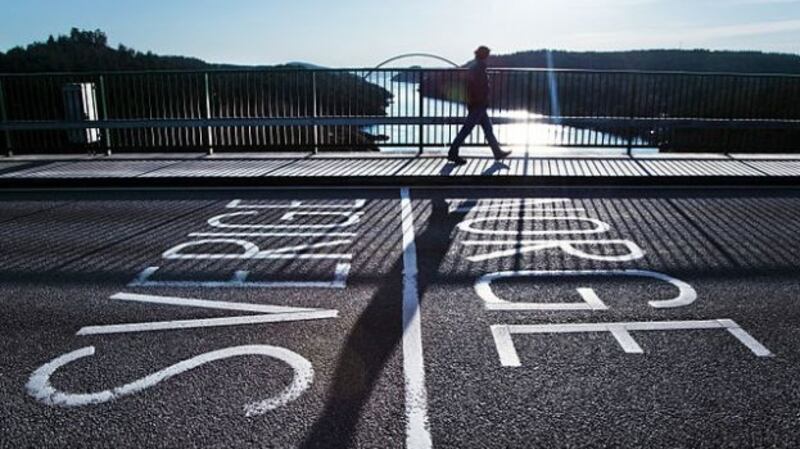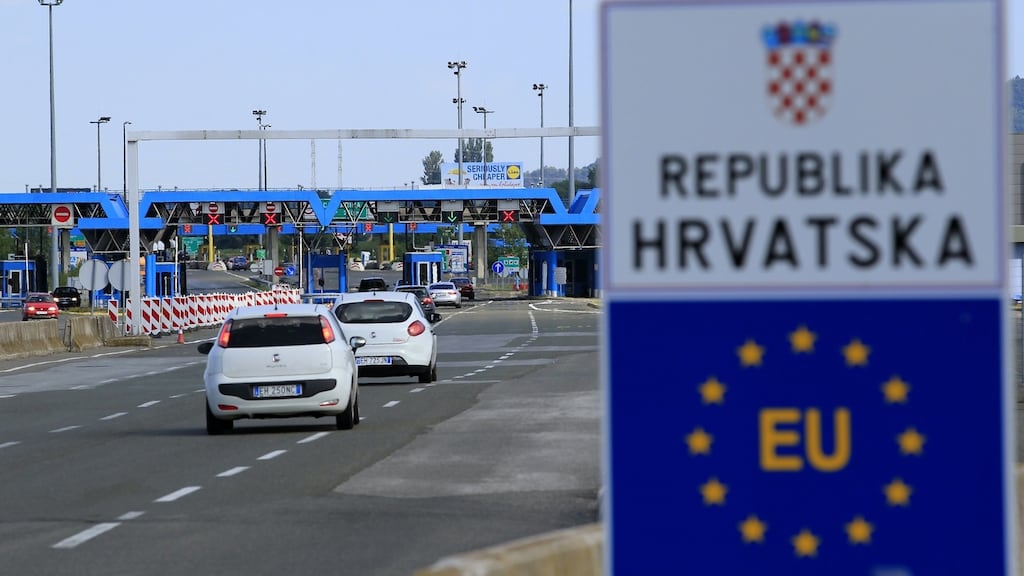Drive south along Croatia’s Adriatic motorways and eventually you will stumble on the kind of border headache that some in both the Republic and Northern Ireland fear, and no one wants.
An hour-long tailback at the border with Bosnia and Herzegovina leaves motorists fuming. A desultory passport check ensues before everyone is on their way again – but not for long. Ten miles further south there’s another border, this time crossing from Bosnia back into Croatia.
When Croatia joined the EU in 2013, these became hard borders overnight.

When Britain finally leaves the EU, the same issues will rear up along the 500km frontier that separates Northern Ireland and the Republic.
Officials on both sides seem determined that no hard Border will re-emerge. But questions remain: how will customs enforce differences in tariffs without searching trucks? If the Border is not policed, how will EU nationals who migrate to the Republic be prevented from moving to Northern Ireland and onward to Britain?
Balkan divides
Like the North-South Irish divide, the 930km dividing line in the Balkans cuts across cultural, family, and business ties. Bilateral trade is worth €1.3 billion.
When Croatia joined the EU on July 1st, 2013, the bloc’s external frontier was redrawn along Croatia’s borders with Serbia, Montenegro, and Bosnia and Herzegovina. The border with the latter has proved particularly troublesome. Both countries were once republics of Yugoslavia, and 15 per cent of Bosnia’s citizens are ethnic Croats, most of whom have Croatian EU passports.
In some cases, the results are surreal: houses and farms that are partly in the EU and part not, and farmers who need to show their IDs to get to and from their own fields across the border.
Ivan Glavota runs a winery centred on a 100-year-old wine cellar in Imotski, a picturesque small town on the Croatian side, perched on cliffs above a striking azure lake. He has some 1,000 vines on the Bosnian side of the border.
Along with the occasional bureaucratic hassle of crossing the frontier to his own land, Glavota is not able to obtain either EU or Croatian funding for the grapes harvested across the border, though the wine itself is made in Croatia. “This creates a problem for numerous small agriculture producers in the area,” he says.
The border has become synonymous with frustrations: Bosnian agricultural exports can only be exported to Croatia through two customs posts on their long frontier, which pushes up costs. Tariff-free trade privileges were suspended temporarily earlier this year during a bureaucratic wrangle.
“People tend to sometimes forget that Croatia is now part of different system, that things are not like they used to be,” says Amer Kapetanovic, an assistant minister in Bosnia’s foreign ministry.
“All these bureaucratic nuances suddenly became very important, and this is the moment of realisation that Croatia is in the EU and we are not, despite the fact that we used to live together in one state. We speak the same language, listen to the same music, have the same jokes, have family either side of the border.”
Kapetanovic warns his counterparts in the UK and Ireland to avoid a clean break when it comes to Brexit negotiations.
“It would be wise if during the negotiations on article 50, both the UK and Ireland strongly opt for continuing with an open border policy,” he says. “As neither are part of Schengen, I think it would be the wisest approach. Otherwise some of our examples affecting our daily life with our EU neighbour Croatia might appear in your situation as well, and I’m sure your people would not like it.”
Hard tariff border
Some 2,000 miles to the north, another EU frontier provides further insights of what happens when two close trading partners find themselves on either side of a hard tariff border.
In the Swedish town of Charlottenberg, one of Europe’s largest sweet shops has mushroomed, fed by the very different price of sugar in Sweden and Norway.
Every weekend, Norwegians fill their boots, literally, from the 4,000 varieties of cheap candy in stores such as Gottebiteng, which is almost the size of a football field.
Enormous Swedish shopping centres within driving distance of the capital, Oslo, cater to Norwegian demand for low-tax tobacco, alcohol and sweets. Here, the creation of the Nordic Council saw passport-free travel and a common labour market implemented across the Nordics. Sweden’s accession to the EU in 1994 did not change the arrangement.
Indeed, the EU's Interreg programme now spends as much as €20 million a year on strengthening economic cooperation across the border. "The EU wants to have good relations with its neighbours," says Michael von Essen, a project officer for Interreg on the Swedish side.
A substantial number of Norwegians live in Sweden and commute to work in Oslo to benefit from lower house prices and tax breaks that flow from Swedish residency. Buying a car is cheaper, for example.
Some Norwegian companies like to establish themselves inside the EU, so they open small offices in towns such as Strömstad, 130km from Oslo, according to Peter Dafteryd, a councillor for the ruling centre-right group on Strömstad’s town council.
“That way they have a daughter company in the EU, with quite different taxes and regulations,” he says. “It’s a way of getting into the EU without being a member.” Norwegians bring more than 8 billion Swedish kroner into the Strömstad area every year, paying the salaries of some 2,000 Swedes, he adds.
The two countries that once split apart have grown closer together, despite one being inside the EU and the other outside. So could Norway and Sweden hold any lessons for the future of Britain and Ireland?
“Passport-free movement while Norway is not an EU member is quite unique,” Dafteryd says. “The problem in Ireland is that that kind of arrangement has not been prepared. It will be a struggle for both sides, I think.”
Schengen neighbours
Another model for the future of the British-Irish Border may be glimpsed where Germany meets Switzerland. While the latter is not part of the EU, it did sign the Schengen agreement in 2004, a decision affirmed by the Swiss public in a referendum a year later.
Officially, there have been no border controls between the two countries on land since December 12th, 2008, and flights between the two have been denoted “inland flights” since March 29th, 2009. This means that nowadays you only need to show your ID card to board a flight from Berlin to Zurich – and you can walk from Basel to Weil am Rhein without any documents whatsoever.
Apart from the odd cow fence, there are no fortifications along the 362km border. Som 54,000 people who live in Germany freely commute between the two countries every day.
Still, because Switzerland is not part of the EU’s customs union, both states still have to carry out some checks at the crossings. For example, though Switzerland is part of Schengen, Germans going on a holiday to the Swiss Alps are not allowed to bring more than two bottles of wine or 500g of beef with them. Likewise, if you buy some expensive skiing kit in Verbier, you have to declare it with German customs when crossing back into the EU.
The task of adjusting the filter at border points to separate human traffic from goods traffic has created headaches for authorities ever since the current regime was put into place. Swiss customs officials are also required to carry out ID checks if there is a security issue at stake, and not just at fixed border points but also via mobile units that operate along the border.
Since the start of 2015, even couriers who deliver pizzas from an Italian restaurant in Weil am Rhein to Basel – 3km – down the road have to declare their stone oven-baked wares with Swiss customs. It’s easy to see why: a pizza margarita sells for about €4.90 on the German side of the border but about €13 on the Swiss side. It is no coincidence that the term “shopping tourist” was voted the Swiss word of the year in 2015.
Customs officials say they can organise spot-checks without creating tailbacks at border points. Nonetheless, locals in German border cities such as Konstanz complain about Swiss “shopping tourists” gridlocking their medieval city, and struggling customs officials complain that they have to hire extra staff just to stay on top of the paperwork.
Germany reintroduced controls on the border with Austria at the peak of refugee crisis. This has also had an impact on the Swiss-German border. Germany’s federal police force says it currently carries out “intensified” controls, which fall just short of temporarily reintroducing border controls.








